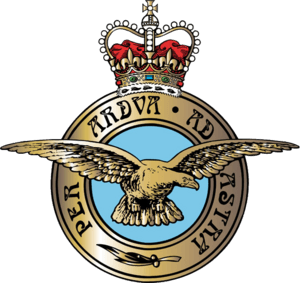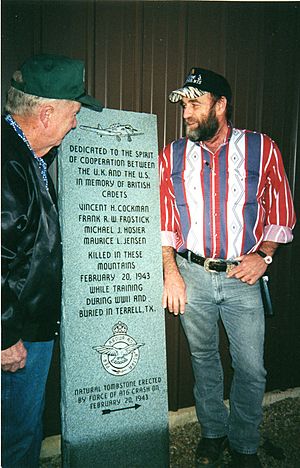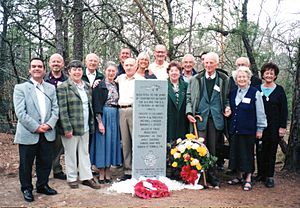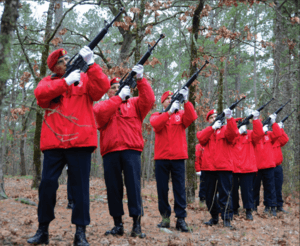AT6 Monument facts for kids
Quick facts for kids AT6 Monument |
|
|---|---|
| Big Mountain (Pushmataha County, Oklahoma) | |

Flag of the Royal Air Force
|
|
| For Royal Air Force fliers who crashed into the Kiamichi Mountains during World War II | |
| Unveiled | February 20, 2000 |
| Location | near |
| Designed by | Allen Parsons |
|
Dedicated to the Spirit of Cooperation Between the U.K. and the U.S. in Memory of British Cadets Killed in These Mountains February 20, 1943
|
|
The AT6 Monument is a stone memorial built to remember Royal Air Force cadets. These young pilots died during a training flight in World War II. The monument stands on Big Mountain, near Moyers, Oklahoma, in the United States. It was officially opened on February 20, 2000. This date was exactly 57 years after the tragic plane crashes.
Contents
Why the AT6 Monument Was Built
Training Pilots During World War II
During World War II, it was hard for the United Kingdom to train its Royal Air Force pilots. The skies over Britain were full of air battles. So, British student pilots went to other countries like Australia, Canada, South Africa, and the United States for training.
In the U.S., they set up RAF training schools in places like Miami and Norman, Oklahoma. Another school was in Terrell, Texas. Students learned important skills like navigation, how engines work, and how planes fly.
Practice Flights and "Fake" Cities
The aviation cadets at Terrell used a clever way to practice. They imagined a map of Europe laid over parts of Texas, Oklahoma, Arkansas, New Mexico, and Mississippi. They chose Terrell, Texas, to be "London, England."
Other cities in the U.S. became "fake" European cities at specific distances. For example:
- Albuquerque, New Mexico was "Warsaw, Poland"
- Beaumont, Texas was "Paris, France"
- Henderson, Texas was "Dunkirk, France"
- Lubbock, Texas was "Cork, Ireland"
- Turner, Arkansas was "Emden, Germany"
- Vicksburg, Mississippi was "Cologne, Germany"
A big part of their training was flying often. These training flights helped students get used to real flying conditions. They often flew in groups, just like planes would in a real war.
The Crashes
The Tragic Day
On February 20, 1943, a group of British training planes took off from Terrell, Texas. They were heading to Miami, Oklahoma. The students were flying twelve AT-6 training planes. The AT-6 was a two-seater plane with one engine. It was used to teach advanced flying skills.
Their goal was a low-level, cross-country training flight. But bad weather made the flight very difficult, especially as they neared the Kiamichi Mountains in Pushmataha County, Oklahoma. Local people said the weather was terrible. One person described it as very foggy with a rainy mist.
The pilots faced the same bad weather in the air. They had not been told what to do if they met such conditions. Some planes turned back to Terrell, but others kept going. Twelve planes made it to Miami safely. However, three planes ran into serious trouble.
Two Planes Crash
One pilot, John Wall, said, "I found myself trapped in a valley with no idea where we were or where the high ground might be." Wall and his navigator, "Wilbur" Wright, decided to land their plane safely in a field. They landed in Bedford's meadow, near the small community of Jumbo. Local people helped them and gave them a place to stay overnight.
Sadly, the other two planes had a tragic end. They were flying several miles to the east, over the town of Moyers, Oklahoma. The mountains behind Moyers rise very steeply. One AT-6 plane crashed into the side of White Rock Mountain. The plane hit a tree, and both pilots died.
The pilot was Vincent Henry Cockman, 20, from Ilford, England. His navigator was Frank Frostick, 21, from North Walsham, England. Local rescuers believed the pilots might have lived if the plane hadn't hit the tree.
The third missing plane flew over White Rock Mountain but then lost control. It spiraled down into Big Mountain. Big Mountain is between Moyers and Kosoma. This third crash site was harder to find and was not discovered until the next day.
This plane was flown by Mike Hosier, 19, from Swindon, England. His navigator was Maurice Jenson, 19, from Bournemouth, England. The plane hit the mountain straight on. Rescuers found something strange: the force of the crash had pushed a large rock out of the ground, making it look like a natural tombstone. This unusual sight stayed with the rescuers for many years.
All four bodies were taken to Antlers, Oklahoma, the largest town in Pushmataha County. From there, they were taken to Terrell, Texas. They were buried in the British burial ground at Oakland Memorial Park cemetery.
Building the Monument
Students Take Action
Many years later, students at a school in Rattan, Oklahoma, learned about the crashes. Rattan is a small town east of Antlers. The sixth-grade boys' reading class, taught by Beth Lawless, decided to research the crashes.
After weeks of research, the students felt that the crash victims should be remembered. They were sad that local people no longer remembered this part of their history. They also felt it was sad that the families in England had no proper way to say goodbye.
The boys decided to build a marker at the crash site on Big Mountain. This spot was chosen because it was known and easier to reach. The crash site on White Rock Mountain was much harder to get to.
Community Support
A local craftsman who made grave markers offered his time and work for free. The students raised money to pay for the materials. They were successful, and the marker was made from granite. It is tall and has information about the crash carved into it.
The students then found the surviving families in England. They also found John Wall and Wilbur Wright, the two pilots who had landed safely. John Wall had moved to New Zealand after the war.
News of the students' project reached British Airways and Air New Zealand. British Airways gave 18 free tickets for the students to use. Air New Zealand offered to fly John Wall to the ceremony for free. The students used the tickets to fly all the surviving family members and Wilbur Wright to Dallas, Texas. Reporters from the British Broadcasting Corporation and newspapers like The Daily Telegraph also came.
The Dedication Ceremony
The monument was officially opened on February 20, 2000. This was the 58th anniversary of the crashes. Over 1,000 people came to the mountaintop for the ceremony. News of the event was shared across England and in many newspapers worldwide.
Special guests included officials from the British and New Zealand embassies. The British vice consul from Houston also attended. All of them said it was a very special event. They were amazed that students from a small, rural area had achieved such a big task.
The monument stands next to the "natural tombstone" in a quiet area of pine trees. Visitors can easily reach the site from Oklahoma State Highway 2. A sign helps guide people from the highway.
John Wall shared his thoughts about that day in 1943. He told the students, "Turning back sooner would have been the smart thing—but then, youth always presses on."
Yearly Commemorations
Small ceremonies have been held at the monument every year since 2000. The Choctaw Nation's Color Guard often presents the flags, including Britain's Union Jack. The Veterans of Foreign Wars chapter in Antlers also helps, hosting gatherings after the ceremonies.
In recent years, Royal Air Force officers stationed in Texas have joined the yearly events. They sometimes help clear brush around the monument site. Local residents also help maintain the area.
A special rededication ceremony took place in 2018. This marked the 75th anniversary of the crashes. Britain's Consul General to the U.S., RAF officers, visitors from England, and local residents gathered. The Choctaw Nation helped organize the event. Their Chief and Assistant Chief hosted the gathering. The Choctaw Nation Color Guard and the RAF detachment presented the flags. Students from Rattan, some of whom are Choctaw, sang "God Save the Queen" and placed roses near the "natural tombstone."
Images for kids









